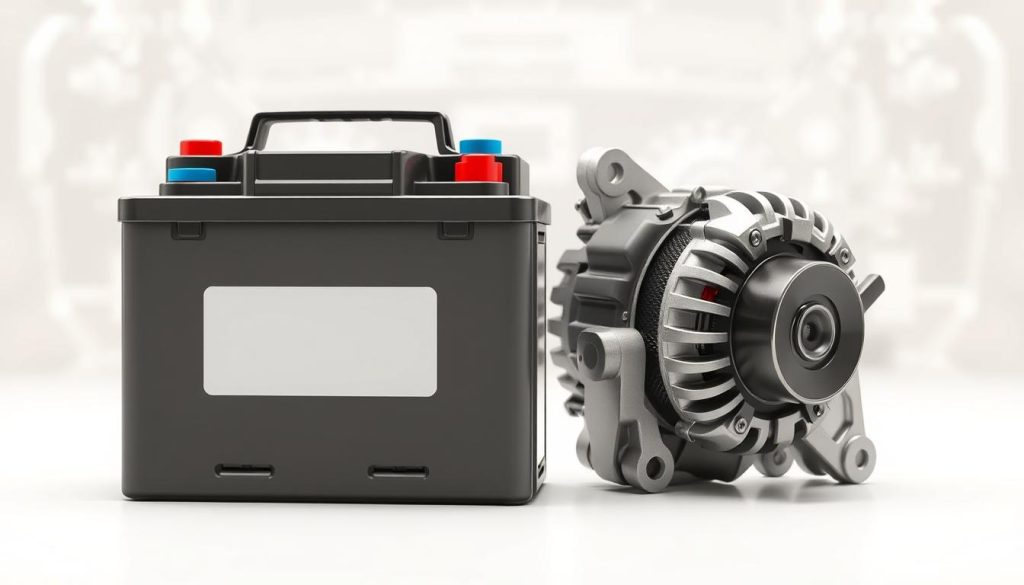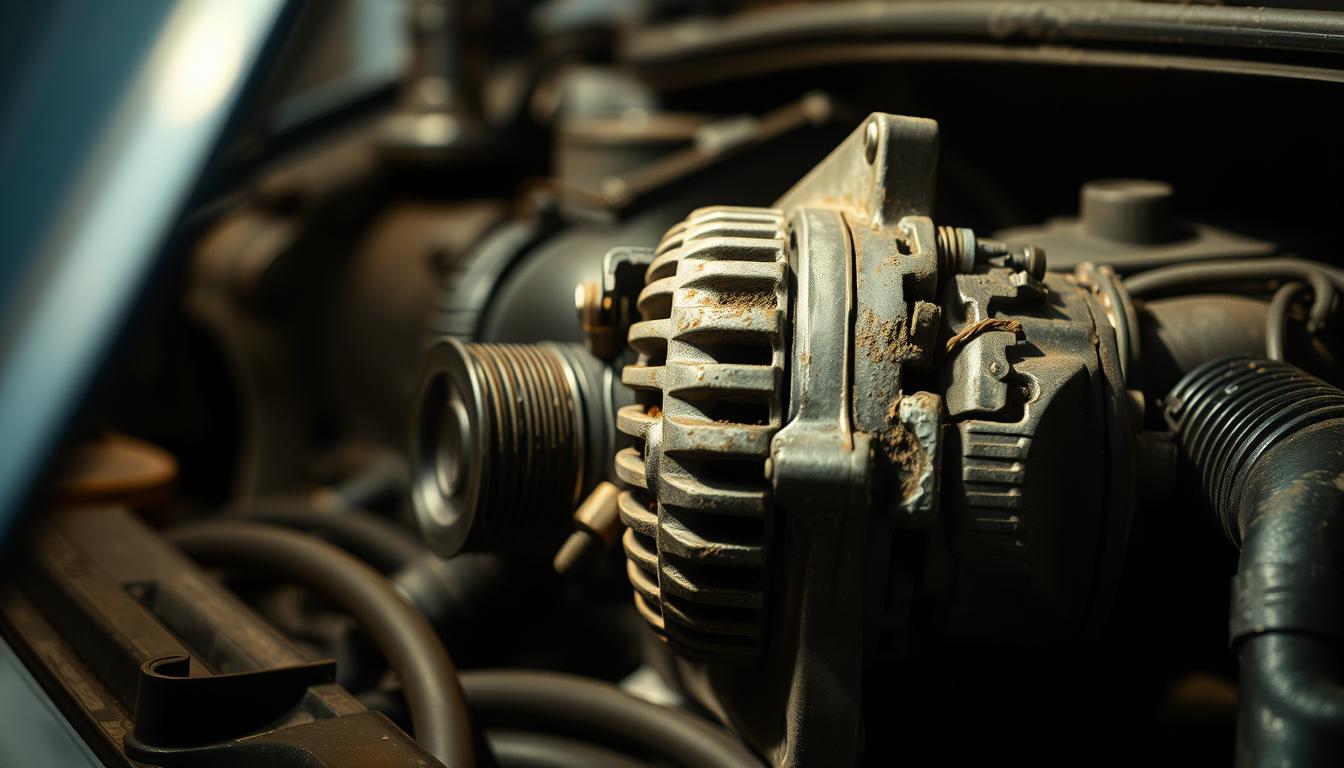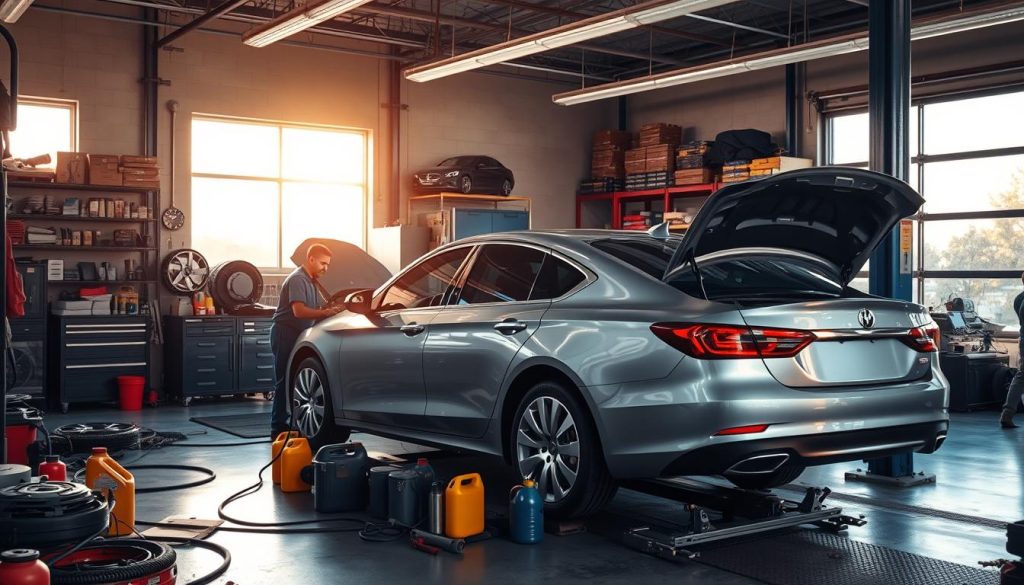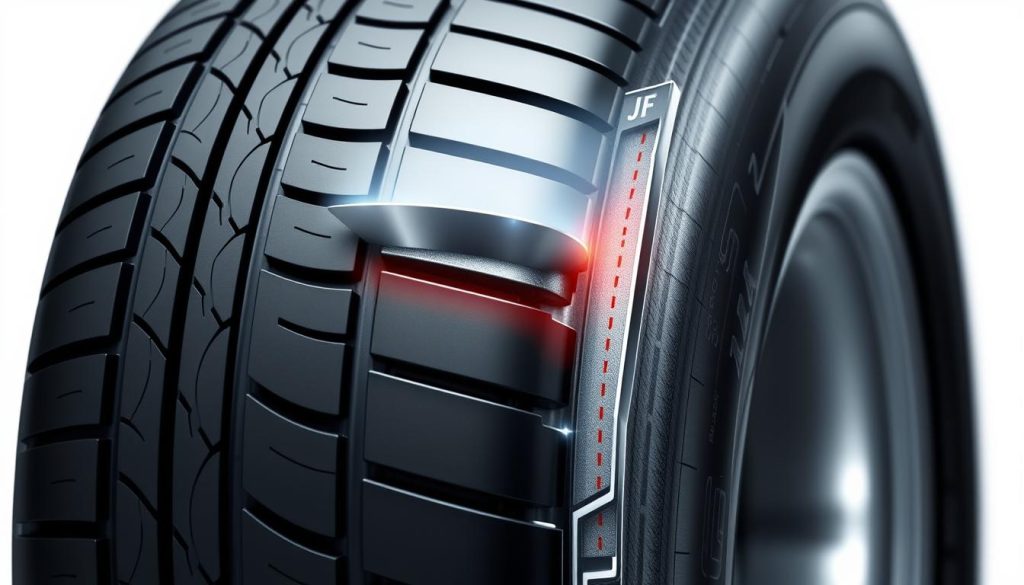The alternator is key for our car’s electrical system. It keeps the battery charged and powers car accessories. We must spot signs of a failing alternator to avoid breakdowns and expensive fixes.
If the alternator fails, it can cause battery drain, dim lights, and hard engine starts. Knowing these signs is important to fix problems early.
Key Takeaways
- The average car battery lasts between 3 to 5 years, making regular checks critical.
- Look for warning signs such as dimming lights or dashboard battery indicators to assess alternator health.
- Leaving accessories on can lead to battery drain and reduced lifespan.
- A voltage reading below 14.2 volts while the engine is running may indicate alternator issues.
- Professional inspection is advisable once symptoms of failure are detected.
Understanding the Role of the Alternator
The alternator is key in our car’s electrical system. It turns engine power into electrical energy. This energy is needed to charge the car battery and power other parts.
What Does an Alternator Do?
An alternator makes electrical energy when the engine is on. It makes 13.5 to 14.5 volts. This power is used to charge the battery and run the electrical system.
If the alternator fails, the battery will drain fast. This can cause starting problems and damage to electronic parts.
Signs of a Healthy Alternator
Knowing when the alternator is working right is important. A good alternator shows:
- Stable voltage between 13 to 14.5 volts.
- Dashboard lights that stay bright without flickering.
- Electrical accessories like the radio and air conditioning work well.

Checking the electrical system, including the alternator, often helps avoid problems. Knowing how the alternator works helps us take care of our cars. This can save us from expensive fixes.
Common Symptoms of a Failing Alternator
Knowing the signs of a failing alternator can save us money and keep our car running well. Look out for dimming lights, battery troubles, and odd noises. Spotting these signs early helps us fix problems fast and stay safe driving.
Dimming or Flickering Lights
Dimming lights are a big sign of a failing alternator. You might see flickering headlights or dashboard lights. This means the alternator can’t give enough power to our car’s lights and gadgets.
As we use more things in the car, this problem gets worse. It can make driving unsafe.
Weak or Dead Battery
A weak or dead battery often means the alternator is broken. If the battery doesn’t charge when the car is running, it won’t last long. A lit battery light on the dashboard is a big warning.
Need to jumpstart your car a lot? Or does your battery die fast? The alternator might be the problem.
Unusual Sounds
Strange noises from the engine area are another sign. Whining, grinding, or squealing sounds mean the alternator is wearing out. If you hear these, act fast.
These sounds can mean serious damage to your car’s electrical system. They might even cause your car to stall while you’re driving.

Diagnostic Steps to Confirm Alternator Issues
We need to follow a systematic approach to diagnose alternator problems. Understanding symptoms and conducting thorough checks can help. The main steps include visual inspections, battery testing, and watching warning lights.
Visual Inspection
A visual inspection is our first step. We look for:
- Wear or damage on the alternator itself.
- Loose connections that could disrupt electrical flow.
- Burnt or frayed wires that may affect overall functionality.
Fixing any visible issues can stop bigger problems later.
Testing Battery Voltage
Then, we test the battery voltage. A good alternator should give 13.8 to 14.4 volts when the engine is on. If it’s less than 13 volts, even after charging, the alternator might not work right. This could mean a weak battery that dies fast if the charging system fails.
Checking for Warning Lights
Lastly, we watch for dashboard warning lights. If the battery or charging light flickers, it usually means the alternator is not working right. This can hurt our vehicle’s performance and safety.
The Process of Alternator Replacement
Learning about the alternator replacement process helps us take better care of our cars. Knowing when to replace the alternator is key to avoiding breakdowns. Signs like constant battery problems and odd noises while driving mean it’s time for a new one.
Spotting these signs early helps us fix issues before they get worse. This way, we can avoid surprises and keep our cars running smoothly.
When to Replace the Alternator
When to replace the alternator depends on a few things like how far the car has traveled and how well it’s working. Usually, we should think about replacing it around 100,000 miles. This is when many alternators start to not work as well.
Other signs like lights flickering or the battery dying a lot mean it’s time for a new one. Sometimes, fixing it might work, but only about 15% of the time.
Tools Needed for Replacement
To replace the alternator, we need some important tools. Here’s what we should have:
- Socket set
- Wrench set
- Screwdrivers
- Memory saver
- Gloves
- Safety glasses
A multimeter is not a must-have, but it helps a lot. It lets us check the electrical system before and after we replace the alternator. Having the right tools makes the job easier and keeps our car reliable.
Tips for Preventing Future Alternator Problems
To keep our cars running well, we must do regular maintenance. We should check the alternator and battery often. This helps catch problems early.
Regular Maintenance Checks
Regular checks are key. We should look at the alternator belt every six months. Also, make sure battery connections are clean and tight.
Doing this can lower the chance of alternator problems by 40%. It also makes the belt last longer, up to 50% more.
Quality Parts for Replacement
When fixing things, use good parts. OEM parts make the alternator last longer, about 30% more than cheaper ones. This saves money in the long run.
Recognizing Early Signs of Trouble
Watch for signs of trouble early. Sounds, dashboard lights, and dim headlights mean something’s wrong. Catching these signs early saves money, up to 60%.



